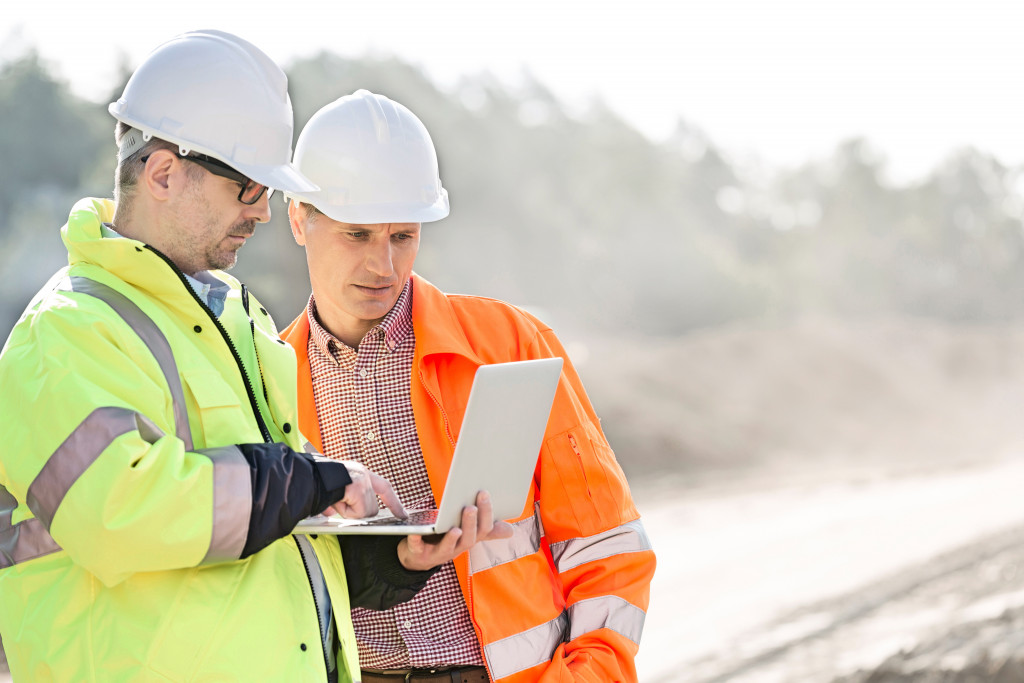- Securely quarantining potential dangers is essential to minimize accident risks on construction sites.
- Regularly inspect equipment and effectively train workers on how to handle tools safely.
- Personal Protective Equipment (PPE) must always be worn in hazardous conditions to ensure worker protection.
- Stabilize ladders before use and operate heavy machinery cautiously to avoid dangerous situations.
Construction sites are inherently dangerous places, and it is essential to take safety precautions seriously to minimize the risks of accidents. By accepting these preventative steps and more, businesses can create a safer environment for everyone working on or visiting a construction site.
Secure the whole site.
Securing the whole construction site is a critical task for minimizing accident risks. It’s so important to be done correctly and with great attention to detail to ensure safety is a top priority. This could involve hiring erosion control services. Doing this helps protect the workers from harm and preserves the property from damage.
Securely quarantining any potential dangers beforehand can save everyone time and money and ensure the safety of the construction workers involved, which should always be a priority number one.
Ensure safety in equipment use.
Here are some tips on how you can ensure safety when equipment is in use:
Regularly inspect equipment

Inspecting construction tools, materials, and machinery is essential to any successful project. Failing to check these items can lead to various hazards on the work site, including potential accident risks. Additionally, having a comprehensive inspection policy helps ensure proper preventive measures are taken should any damages or defects be found.
Not only does this help produce better results, and also contributes to a safe working environment where employees and other personnel may feel secure while on the job. Consequently, inspecting construction equipment is a crucial strategy for minimizing accident risks in construction sites.
Train workers on how to handle tools safely.
Training workers on handling tools safely is essential to preventing accidents on construction sites. Properly training everyone who uses the devices ensures that they are used correctly and according to their intended purpose.
Teaching workers best practices for operating and maintaining equipment decreases the likelihood of them making dangerous errors when working with the tools. Safety discussions should also include:
- Proper lifting techniques.
- Prevention of slips and falls.
- Hazardous waste handling guidelines and safety protocols for everyday tasks.
As even minor mistakes can easily result in serious injuries or disasters, practical tool-handling safety training is essential because it encourages safe behavior and reduces the risk of harm to personnel, property, and finances from unsafe work practices.
Ensure that PPE is worn at all times in appropriate areas.

Properly utilizing Personal Protective Equipment (PPE) helps reduce the risks of serious harm on construction sites. Before entering a high-risk area, workers should be thoroughly briefed on wearing protective clothing and using it correctly. They need to understand that PPE keeps them safe, and any lapse in appropriately adhering to safety rules can harm them.
Working in hazardous conditions requires focus and concentration; accidental slips or omissions can result in costly errors or fatalities. To ensure PPE is worn at all times in appropriate areas, supervisors should observe workers throughout the workday and conduct regular spot checks to make sure everyone is conforming to set safety regulations.
Appropriate educational material should also be made available before anyone enters a high-risk work area so they fully comprehend their responsibilities regarding using PPE. Overall, proper usage of PPE is paramount in minimizing accident risk on construction sites.
Ensure ladders are stabilized and secure when in use.
Ensuring ladders are stabilized and secure when in use at construction sites is of utmost importance. If a ladder is not stable, it poses an immense accident risk to all onsite personnel, as well as members of the public in the vicinity.
Stabilizing a ladder includes placing its base against a solid wall or surface and covering any uneven parts with wooden planks to avoid slippage. This process should be repeated each time the ladder is repositioned–no matter how slight the shift may be–to guarantee safety for everyone in the area. By following these steps, you can prevent hazardous situations from occurring and save lives.
Use caution when operating heavy machinery.
Heavy machinery’s safe and secure operation is crucial for running a successful construction site without accidents. You must be conscientious when operating any machinery on-site by thoroughly understanding the instructions, adhering to safety precautions, staying alert and focused, and maintaining all equipment regularly.
Doing this minimizes the risk of injury or death and contributes to occupational efficiency, significantly reducing project costs. You must remember how critical proper use of heavy machinery is – your lives and your colleagues depend on it.
These are just a few of the many safety strategies, you can put into practice to help ensure everyone’s safety on construction sites. By following these precautionary measures, businesses can create safer environments for their staff and visitors alike.

